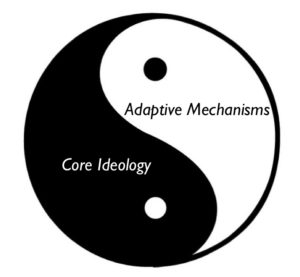I admire chameleons; many can change colors as a means of adapting to their environment, avoiding predators and pursuing their livelihood (insects mainly.) I’ll admit to having a near life-long interest in reptiles of any kind, but what I admire most about chameleons is their capacity to adapt while maintaining their “chameleoness.” I’m afraid we are witnessing many organizations, even entire industries, that unlike chameleons are attempting to adapt but in the process abandoning their core identities. Chameleons adapt while remaining authentic; they are still in the end chameleons. Authentic organizations and authentic professions take care to preserve their core identities, like chameleons adapting effectively to changing environments while staying true to their purpose and what they stand for.
A recent conversation with a doctor friend brought chameleons to mind. She described how new rules, automation and administrative or bureaucratic requirements have been chipping away at her time devoted to “doctoring” for years. More than half of her time is spent at a terminal, completing paperwork or performing other administrative tasks, leaving less and less time each year for face-to-face patient consultations. I’ve had similar conversations with high school teachers and college professors who find decreasing portions of their time available for the true work of teaching on account of administrative and record-keeping requirements. The effects of decreased time available for teaching are magnified by a surge in administrative to teaching staff ratios at colleges and universities. Forty years ago there were nearly twice as many teaching to administrative staff on college campuses; today the ratios are reversed. (And an increasing number of administrative staff are occupied, or preoccupied, with a university’s athletic business – another story.) Does this cause you to question if the business of health care is still health care and healing, or if the business of schools and universities is still teaching and learning?
I fear that “news” channels and newspapers stopped thoughtfully reporting the news or offering news analysis about the time that Walter Cronkite went off the air dozens of years ago. Today most conventional channels and newspapers pay attention to the same polls and ratings as reality shows and sitcoms that compete for attention; and why shouldn’t they since morphing into their own brand of entertainment? The once noble purpose of informing a citizenry and building its capacity to think critically appears to have been abandoned.
What about the “business” of our religious and church institutions? How far have some of them drifted from their original missions by adapting to popular tastes and economic realities?
Financial institutions must navigate a challenging environment these days, including historically low interest rates, intense competition, global uncertainty, carryover mistrust from their roles in the great recession and increased regulation that stemmed from excesses leading up to the recession. It’s no wonder that efforts to adapt and compete in such an environment include seeking any opportunities for shoring up revenue, but at what cost? Wells Fargo was recently fined $ 185 million and dismissed 5,300 employees on account of overly aggressive sale tactics that included opening unwanted and “dummy” accounts to meet aggressive revenue goals. In addition to significantly damaging Wells Fargo’s brand, what impact do incidents like these have on the trust placed in financial institutions or our confidence that they are true to their stated purpose and values?
This is not an attack on health care, university, media, church or financial institutions; I believe that  in the vast majority of cases these institutions are well intentioned. However it is a caution about mission drift and dangers that can detract from institutional integrity and authenticity. It is acceptable and in most cases desirable to traverse the bounds of how we fulfill our core purpose and principles; it is not OK to abandon our core purpose and principles. Research that constituted the basis of Jim Collins and Jerry Porras’ best selling book Built To Last validated this axiom; most profitable and enduring companies are masters at preserving their “Core Ideology” (purpose and principles) while constantly innovating. (“Adaptive Mechanisms”) As Starbucks’ founder Howard Schultz put it: “Winners see trials as opportunities to reinforce values, not abandon them.“ All stakeholders lose when purpose and principles are abandoned: those whom an authentic purpose originally served, workers who experience daily disconnects between espoused values and behaviors, and stockholders who sooner or later pay the price.
in the vast majority of cases these institutions are well intentioned. However it is a caution about mission drift and dangers that can detract from institutional integrity and authenticity. It is acceptable and in most cases desirable to traverse the bounds of how we fulfill our core purpose and principles; it is not OK to abandon our core purpose and principles. Research that constituted the basis of Jim Collins and Jerry Porras’ best selling book Built To Last validated this axiom; most profitable and enduring companies are masters at preserving their “Core Ideology” (purpose and principles) while constantly innovating. (“Adaptive Mechanisms”) As Starbucks’ founder Howard Schultz put it: “Winners see trials as opportunities to reinforce values, not abandon them.“ All stakeholders lose when purpose and principles are abandoned: those whom an authentic purpose originally served, workers who experience daily disconnects between espoused values and behaviors, and stockholders who sooner or later pay the price.
How can we be more like “authentic chameleons,” expertly adapting while staying true to purpose and principles?
- First be clear and honest about the true purpose and principles of our enterprise.
- Make sure everyone knows the true purpose and principles of our institution; screen those in who buy in, and screen out those who don’t.
- Reflect on the true purpose of our work regularly; remind ourselves and those we work with of that purpose and the principles that we believe in.
- Be observant, not only of our shifting environment and competitive requirements, but of efforts to adapt that pose dangers to serving our purpose and principles. (By the way, chameleons have a 360-degree arc of vision and eyes that operate independently – true multi-taskers, and an enviable leadership capacity!)
- Innovate within “friendly boundaries.” Creativity bounded by purpose and principles can yield more opportunities than “no holds bared” approaches. Interface Carpeting’s self-imposed goal of achieving 100% sustainable carpet manufacturing yielded many profitable innovations and a competitive edge.
- Use our industry’s, profession’s and organization’s purposes and principles as “litmus tests” for contemplated strategies and business decisions. Will executing them be true to those purposes and principles?
- Measure what matters. I wonder how much less damage would have occurred at Wells Fargo if there were different measures in place or more attention paid to some measures.
- “If you see something say something.” Let’s adopt this post-9/11 mantra to avert crises in our organizations, having and reinforcing the courage to call out practices that detract from purpose and principles.
Are you an “authentic chameleon”? Is your profession and organization?
What will you do increase your adaptability while honoring your purpose and principles?
“There can be no happiness if the things we believe in are different from the things we do.”
Freya Madeline Stark
“The shortest and surest way to live with honor in the world is to be in reality what we would appear to be.”
Socrates
“It can be really offputting when you lose your way somehow.”
Winnie the Pooh
“A modern view of the processes of growth, decay and renewal must give due emphasis to both continuity and change in human institutions.”
John W. Gardner
“Open your arms to change, but don’t let go of your values.”
Dalai Lama
(Picture credits: “Core Ideology” and “Adaptive Mechanisms” from Built To Last, Harper Business, 1994.)
In the realm of human behavior and relationships, discussions about sexuality often surface, leading to various inquiries and analyses. A question that has piqued the interest of researchers and the general public alike is Who Is More Sexually Active Male or Female. It’s essential to understand that sexual activity can be influenced by numerous factors, including cultural, societal, and individual differences, making it a multifaceted topic to explore. Who is more sexually active male or female





